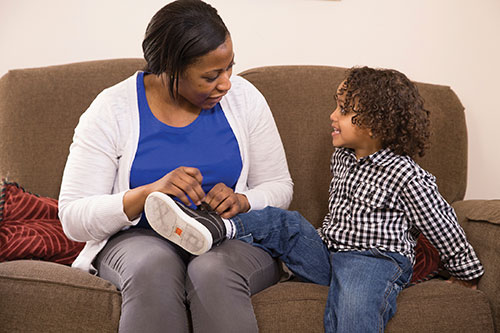Using Effective Praise to Promote Good Behavior
 Praise is one of the most powerful tools parents can use to teach their children positive skills.
Praise is one of the most powerful tools parents can use to teach their children positive skills.
Taking away privileges and giving Time-Outs can be effective when correcting misbehavior; however, recognizing and praising improved and good behavior helps to reinforce that behavior and reduces problem behaviors.
Practicing Effective Praise
Praise works best when it is given effectively and you remember to use it consistently and frequently.
-
Look for the good things your child does, even the small things.
-
Remember to praise the things your child already does well, improvements in his or behavior and positive attempts at using new skills.
There are Three Key Steps to Effective Praise:
-
Show your approval. Use words or actions to show your child you appreciate what he or she just did. Give a smile or a thumbs-up, or use words of affirmation.
-
Describe the positive behavior you saw. Make your comments brief and specific, telling your child exactly what he or she did that was praiseworthy. For example, say “I really liked how you shared your toys with your cousins."
-
Describe how using the good behavior will help your child and how it is appreciated by others. Benefits can range from letting your child play outside longer because he or she has earned your trust to having your child make a friend feel more welcome in a social situation.
 Tips for Using Effective Praise
Tips for Using Effective Praise
-
Give the praise immediately or shortly after you notice the behavior.
-
Verbal attention is beneficial, but physical attention is better. Give your child a hug or pat on the back to show how proud you are.
-
Occasionally use tangible rewards. These can include bike rides with Mom or an ice cream treat with Dad.
-
Apply the “4-to-1" rule. That means that for every negative behavior you notice and correct, find four positive behaviors or reasons to praise. This is a good way to remember to look for positive behaviors.
Additional Resources
-
Help! There's a Toddler in the House! by Thomas M. Reimers, Ph.D.
-
I Brake For Meltdowns: How To Handle The Most Exasperating Behavior Of Your 2- To 5-Year-Old by Michelle Nicholasen and Barbara O'Neal
-
Parenting the Strong-Willed Child: The Clinically Proven Five-Week Program for Parents of Two- to Six-Year-Olds by Rex Forehand and Nicholas Long
Download Printable Version
Kid Tips;Discipline;Family and Parenting
